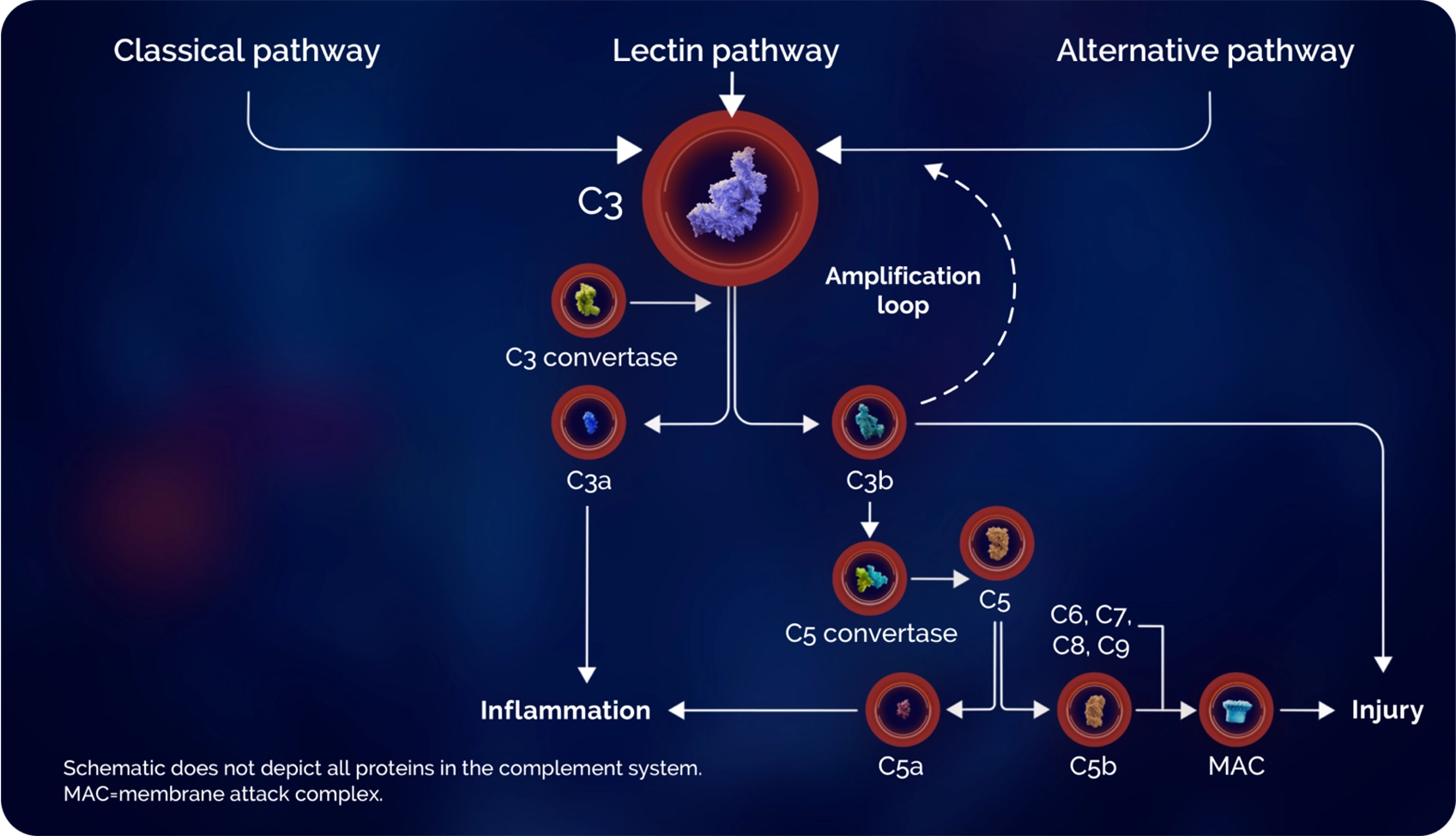The central role of C3 in complement overactivation
 Actor portrayal.
Actor portrayal.
The link between complement overactivation and kidney function decline
Overactivation of the complement system is the underlying cause of C3G and primary IC-MPGN. The overactivation results in continued breakdown of C3 and subsequent buildup of C3 breakdown fragments in the kidneys.1-6
The excessive deposition of these fragments in the kidneys plays a role in driving inflammation and kidney function decline, which can eventually lead to kidney failure.1-6

C3 and the other complement components of the pathway involved in the disease pathogenesis are highlighted in red.
The central role that C3 plays in complement activation and disease pathology

The complement system, a critical part of the immune system, works to eliminate pathogens and damaged cells from the body2,7,8
The complement system can be activated via 3 different pathways—classical, lectin, and alternative—but all converge at the central C3 complement protein2
Although overactivation of the alternative pathway is associated with C3G and both the alternative and classical are implicated in primary IC-MPGN, C3 plays a central role across all 3 pathways2,8,9
Explore complement overactivation and the role of C3
The progressive, severe nature of C3G and primary IC-MPGN and their heterogeneous patient populations highlight the need for more treatment options2,10,11
Further explore the limitations and burdens of current options for managing C3G and primary IC-MPGN
C3G=C3 glomerulopathy; IC-MPGN=immune complex membranoproliferative glomerulonephritis.
References: 1. Donadelli R, Pulieri P, Piras R, et al. Unraveling the molecular mechanisms underlying complement dysregulation by nephritic factors in C3G and IC-MPGN. Front Immunol. 2018;9:2329. 2. Smith RJH, Appel GB, Blom AM, et al. C3 glomerulopathy — understanding a rare complement-driven renal disease. Nat Rev Nephrol. 2019;15(3):129-143. 3. Caravaca-Fontán F, Lucientes L, Cavero T, Praga M. Update on C3 glomerulopathy: a complement-mediated disease. Nephron. 2020;144(6):272-280. 4. Mastrangelo A, Serafinelli J, Giani M, Montini G. Clinical and pathophysiological insights into immunological mediated glomerular diseases in childhood. Front Pediatr. 2020;8:205. 5. Fakhouri F, Le Quintrec M, Frémeaux-Bacchi V. Practical management of C3 glomerulopathy and Ig-mediated MPGN: facts and uncertainties. Kidney Int. 2020;98(5):1135-1148. 6. Sethi S, Fervenza FC. Membranoproliferative glomerulonephritis — a new look at an old entity. N Engl J Med. 2012;366(12):1119-1131. 7. Merle NS, Noe R, Halbwachs-Mecarelli L, Fremeaux-Bacchi V, Roumenina LT. Complement system part II: role in immunity. Front Immunol. 2015;6:257. 8. Baines AC, Brodsky RA. Complementopathies. Blood Rev. 2017;31(4):213-223. 9. Dobó J, Kocsis A, Gál P. Be on target: strategies of targeting alternative and lectin pathway components in complement-mediated diseases. Front Immunol. 2018;9:1851. 10. National Kidney Foundation. Complement 3 glomerulopathy (C3G). Accessed November 6, 2024. https://www.kidney.org/kidney-topics/complement-3-glomerulopathy-c3g 11. Nester C, Decker DA, Meier M, et al. Developing therapies for C3 glomerulopathy: report of the Kidney Health Initiative C3 Glomerulopathy Trial Endpoints Work Group. Clin J Am Soc Nephrol. Published online June 3, 2024. doi:10.2215/CJN.0000000000000505